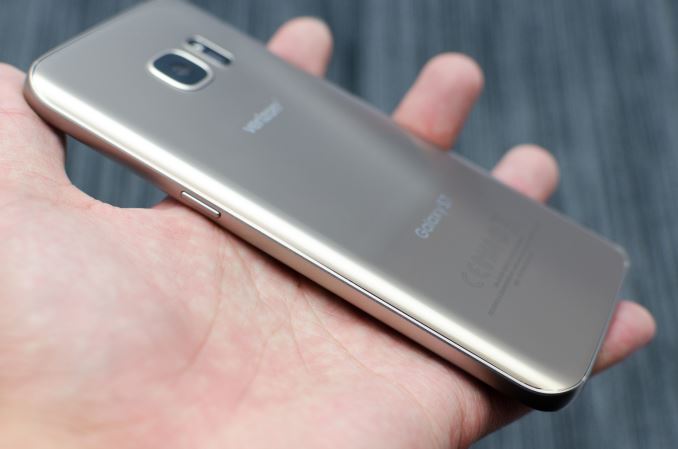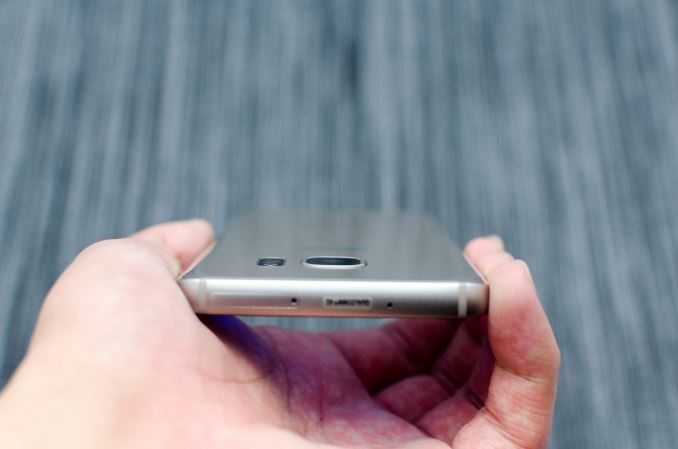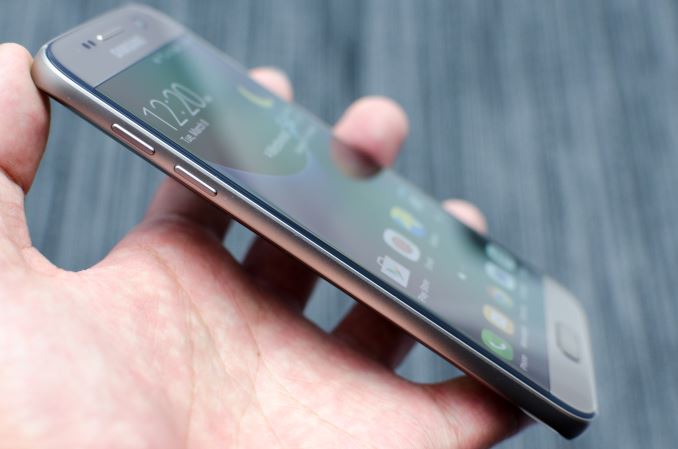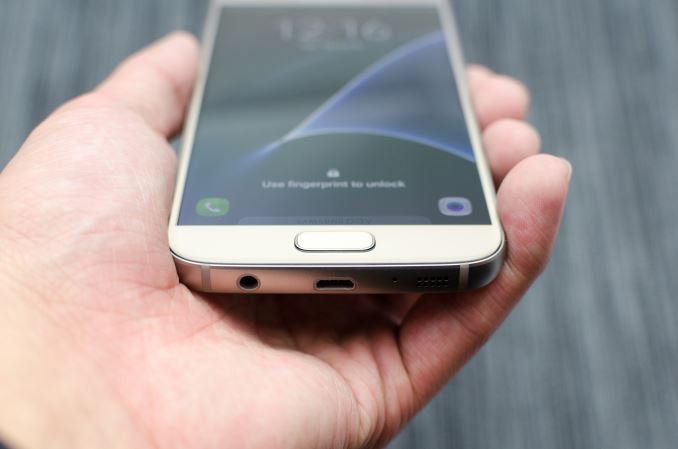The Samsung Galaxy S7 & S7 Edge Review, Part 1
by Joshua Ho on March 8, 2016 9:00 AM EST
For some time now, Samsung has been the dominant player in the Android space, especially at the high end of the market. From the Galaxy S2 onwards, Samsung has been able to ride the wave of the smartphone industry’s growth without much disruption. Samsung has also shown a pretty impressive ability to adapt to changes in the market as seen by their dramatic departure in materials from the Galaxy S5 generation to the Galaxy S6 generation. While the Galaxy S6 was ultimately one of the best phones you could get that year, at least a few design decisions like the loss of removable battery and microSD slot were generally considered to be a step back relative to previous devices.
Throughout their reign of dominance Samsung has always been able to stay on top, however their competition is never too far behind. To that end, it’s probably obvious now that the Galaxy S7 family represents an attempt to improve on the Galaxy S6’s perceived faults, while building upon its perceived strengths. In order to start discussing these changes, we can start by looking at the basic specs and design of the Galaxy S7 and S7 edge.
| Samsung Galaxy S Family | |||||
| Samsung Galaxy S7 | Samsung Galaxy S7 edge | Samsung Galaxy S6 | Samsung Galaxy S6 edge | ||
| SoC | Snapdragon 820 (US, China, Japan) 2x Kryo @ 2.15GHz 2x Kryo @ 1.6GHz Adreno 530 Exynos 8890 (Rest of World) 4x A53 @ 1.58GHz 4x Exynos M1 @ 2.28-2.60GHz Mali T880MP12 @ 650MHz |
Exynos 7420 4x Cortex-A57 @ 2.1GHz 4x Cortex-A53 @ 1.5GHz Mali T760MP8 |
|||
| RAM | 4GB LPDDR4-3600 | 3GB LPDDR4-3100 | |||
| NAND | 32/64GB NAND (UFS) + microSD |
32/64/128GB NAND (UFS) | |||
| Display | 5.1” 1440p SAMOLED |
5.5" 1440p SAMOLED Dual Edge |
5.1” 1440p SAMOLED |
5.1” 1440p SAMOLED Dual Edge |
|
| Network | S820: Qualcomm X12 Integrated 2G / 3G / 4G LTE (Category 12/13) |
2G / 3G / 4G LTE (Category 6) | |||
| Dimensions | 142.4 x 69.6 x 7.9 mm, 152 grams | 150.9 x 72.6 x 7.7 mm, 157 grams | 143.4 x 70.5 x 6.8mm max, 138 grams | 142.1 x 70.1 x 7.0mm max, 132 grams | |
| Camera | Rear Camera w/OIS 12MP (4032 x 3024) Sony IMX260 f/1.7, object tracking AF |
Rear Camera w/OIS 16MP (5132 x 2988) Sony IMX240 / Samsung S5K2P2 f/1.9, object tracking AF |
|||
| Front Facing 5MP, f/1.7 |
Front Facing 5MP , f/1.9 |
||||
| Battery | 3000mAh (11.55 WHr) | 3600mAh (13.86 WHr) | 2550 mAh (9.81 WHr) | 2600 mAh (10.01 WHr) | |
| Launch OS | Android 6 w/TouchWiz | Android 5 w/TouchWiz | |||
| Connectivity | 802.11a/b/g/n/ac 2x2 MU-MIMO + BT 4.2, USB2.0, GPS/GNSS, NFC |
2x2 802.11a/b/g/n/ac + BT 4.1 (BCM4358), USB2.0, GPS/GNSS, NFC |
|||
| Wireless Charging | Yes, Fast Charging | WPC 1.1 (4.6W) & PMA 1.0 (4.2W) |
|||
| Fingerprint Sensor | Touch | Touch | |||
| SIM Size | NanoSIM | NanoSIM | |||
| Launch Price (No Contract) |
$650+ USD | $750+ USD | $650+ USD |
$750+ USD |
|
One of the other major changes in terms of design this time around is electing to go with a significantly larger battery than before. Compared to most other aspects of smartphone technology, battery technology is a more mature field and improves as a slower pace, so the tradeoffs made here result in a thicker device and increased weight relative to the Galaxy S6. However, as we’ll soon see Samsung has made a number of changes in the industrial design which help to mitigate these issues.
Meanwhile, with the Galaxy S7 generation, Samsung has further blurred the line between the Galaxy S lineup and the Galaxy note. The Galaxy S7 edge is a 5.5-inch device - fully into the phablet territory - and only 0.2 inches smaller than the 5.7" Galaxy Note5. This means that the two Galaxy S7 phones are now more significantly differentiated than with the Galaxy S6 generation, where the difference amounted to the dual-edge display and a slightly larger battery. Now the Galaxy S7 edge is larger, ever so slightly heavier, and contains a battery with 20% more capacity than it's base Galaxy S7 brethren.
The final change of note in the Galaxy S7/S7 edge is the camera. With the Galaxy S6 review it was hard to avoid wondering why Samsung didn’t bother to integrate a camera with larger pixel size to improve low light performance, especially when camera was such a significant part of the Galaxy S6 design story with the noticeable camera hump. For the Galaxy S7, Samsung has gone ahead and done just this: the pixel size is now 1.4 micron which should significantly increase the number of situations where the image quality is limited by shot noise rather than image sensor noise. And to top things off the camera hump has now been almost entirely eliminated.
On a quick housekeeping note before we dive in, as we've had less than a week to look at the Galaxy S7, we're dividing up our review into two parts. Today we'll focus on the basics: performance, battery life, design, and the display. Part 2 will go deeper, looking into the Snapdragon 820 SoC in fuller detail, and coupling that with Wi-Fi performance, camera performance, and more.
Design
Now that we’ve gone over the high level changes of the Galaxy S7 and S7 edge, we can start talking about the design of the device. While the Galaxy S6 was an enormous departure from what we were used to seeing from Samsung, the Galaxy S7 is really more an evolution of the Galaxy S6 design. As previously mentioned, it is noticeably thicker and heavier than the Galaxy S6. However, to offset this increase in thickness Samsung has integrated the curved 3D glass of the Galaxy Note5 into the design of the Galaxy S7.
The result of this change is that the Galaxy S7 arguably feels much better in the hand than the Galaxy S6. While I didn’t really have huge issues with the ergonomics of the Galaxy S6, it definitely felt a bit blocky relative to something like the Xiaomi Mi Note Pro and didn’t quite fit in the hand as nicely. The weight increase is noticeable, but not really the end of the world.
The thickness does result in a noticeably reduced camera hump, but on a personal level I never really cared about the camera hump in the Galaxy S6, so I’m not sure I care about the reduction in the camera hump here. I would actually argue that a camera hump is preferable to a camera cover lens that is perfectly coplanar to the back of the phone, as it means that the camera lens isn’t contacting whatever surface I’ve set it down on. While sapphire cover lenses go a very long way to eliminating the potential for scratching a cover lens, there’s also the potential for oil to smear on the camera’s cover lens so I would actually prefer having a camera hump.
The other noticeable change here is the re-introduction of 2.5D curved glass on the edges of the display. I’m not quite sure why Samsung tends to remove and re-introduce this design element seemingly on and off, but it does help with improving the feel of edge swipes at the cost of complicating some things like screen protectors and glass lens durability. Honestly speaking, I’m not sure how much of a difference it makes either way, but it does remove another edge present in the design.
Other than these changes, the design is almost unchanged. The power button remains on the right side of the device and is well-positioned ergonomically. The volume buttons are pretty much in the same place on the left side as well. The 3.5mm jack, micro-USB port, and single speaker are all on the bottom of the device. The only notable deletion in terms of design elements here would be the loss of the IR port on top of the device, which was removed from Galaxy devices starting with the Note5.














202 Comments
View All Comments
jjj - Wednesday, March 9, 2016 - link
One last time , these apps due to the different core configs can change the rankings. The one that gets 20h could go to 12 and the one with 16 to 14h.That was the main point here.Because the vast majority of users have such apps, you can't reach relevant results without factoring them in.A phone can get good results in the current test and poor in actual usage.retrospooty - Wednesday, March 9, 2016 - link
That is an extremely unlikely example. In real world usage, Octa cores have had very little difference in any area (performance or efficiency) vs. their quad core counterparts unless there is an issue with the ROM where it's simple bleeding power. Whatever though, if you feel so strongly about it, by all means, do some testing on various phones and submit to a few sites and see how worthwhile it is.jospoortvliet - Friday, March 11, 2016 - link
I'm no fan of the hitching at the AND team but he has a point with the background tasks - an average modern phone has a lot of them and testing endurance with them all disabled isn't realistic. Moreover, indeed a dual core would probably perform worse with more background tasks than a quad-core or octacore as they can spread the load and keep their cores at an energy-efficient optimal speed.A repeatable, fixed background load would be good to have. Also hard to write, certainly across ios and Android due to their different capabilities and limitations with regards to background tasks. So I get why it hasn't been done and if jjj is up for writing a tool that does it I bet the anandtech team would take it... Yeah.
leexgx - Monday, March 14, 2016 - link
the only thing i find with anandtech is battery tests is that they do not follow real world battery use (to get correct results divide it by about 2 or 2.5 and there is your real battery use, when you look at anandtech reviews, all other tests are good, most phones last around 4 hours Screen on time (max tends to be 4 hours but can be as low as 1.5 hours)the only exception to that rule tends to be the
Motorola RAZR MAXX phones (Low end CPU with 3200 battery),
CUBOT H1 1Ghz Quad core, 720p screen {basicly Samsung Note 2 spec} with Massive 5200 battery, (i own and love, and only costs £110 !!) still miss not having the HTC ONE stereo speakers but i take 8 hours over 2 hours (without having to use an external battery case that turns it into a brick)
and the Huawei Mate 8 (4000 battery)
Andrei Frumusanu - Tuesday, March 8, 2016 - link
GFXBench long term performance is currently not useful to anybody as it hits Vsync in the current T-Rex test. In the full review we'll have a proper test which will be of use for users.jjj - Tuesday, March 8, 2016 - link
Seems that you might be wrong Andrei. I am guessing you got the MI5 but that's 1080p and you forgot to factor that in? Here at 1440p you don't hit the 60FPS wall even in the first run.If the MI5 doesn't fall bellow 60FPS with the 1080p, it would be relatively good news, as it means less than 33%-ish throttling with a 1080p display and no heatpipe.
hansmuff - Tuesday, March 8, 2016 - link
This German review posted some GFXbench results you might be interested in, however ofc their phone uses Exynos. Hard to say that Snapdragon would behave the same way, but it's also clear that having a heatpipe alone in the phone doesn't mean it won't throttle.. significantly at some points.http://www.computerbase.de/2016-03/samsung-galaxy-...
jjj - Tuesday, March 8, 2016 - link
Thanks a lot, ofc has nothing to do with SD820 but having this for the Exynos is nice too.Digitimes was claiming that only the SD820 models have the heatpipe, no clue if true or not, guess it's something else that has to be verified.
jjj - Tuesday, March 8, 2016 - link
The Exynos models do have the heatpipe too.tuxRoller - Tuesday, March 8, 2016 - link
Is that what you do with your phone? Run continuous benchmarks all day?I understand we want an idea about throttling but using those benchmarks as proxy for expected performance won't get you that info about day to day usage.